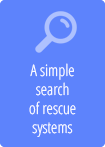Revision of rescue systems
How often should we send the rescue system to the revision?
Every rescue system must be send to the revision during its operating life after a 5/6 years cycle of using. At all rescue systems produced before July 2007 and at rescue systems without the slider is the revision cycle five-year long, at rescue systems with a slider produced from July of the year 2007 is this cycle six-year long. (The frequency of rescue systems revisions you will find in our tables). The date of the revision/the usability time of the specific rescue system is allways marked on the product label.
How is the revision proceeding?
During the revision are controlled all parts of the rescue system. The parachute is unpacked, controlled if it is not damaged, the porosity and the resistence are tested, further it is ventilated, for some days put out and after it anew packed and pressed into the container. The rocket motor will be repaired or changed for a new one. All deficient parts of the rescue system, or parts perishables in the chemical process of aging are changed. At each inspection it is neccessary to change also suspension ropes - polyamide and kevlar.
My rescue system has been mechanically damaged/contaminated/the parachute dipped, will it be in future trouble-free?
In this case you have to send the rescue system ( RS) to the revision immediately. But if the parachute is dipped, at first it is necessary to unpack it, let it dry and subsequently after it send the RS to the revision. If the parachute would be dipped in salt water, it is necessary to dip it at first into sweet water, subsequently let it dry and thereafter send it to the revision.
If you are for any reason not sure, if the system is reliable, please contact immediately us, or any of our dealers.
Test of the parachute – dipped, without revision for 12 years
How to send the rescue system for revision?
Before sending the system to the producer it is necessary to contact your dealer or directly us, to secure a safe transport of the product to the producer.
The product has to be on principle transported in an approved transport box.
What to do after life cycle of the product?
The user must send the product back to the manufacturer after the life cycle of the product. The manufacturer will carry out its delaboration and arrange fuel disposal in accordance with applicable law!!!
Manufacturer will send RS back to the customer after this operation.






























